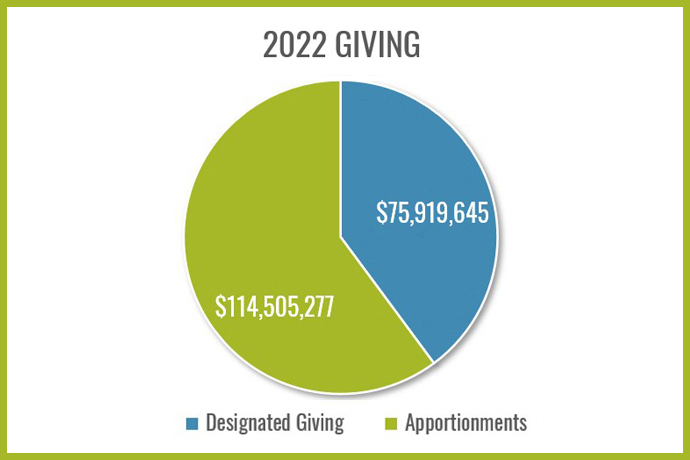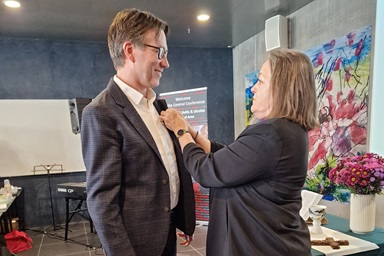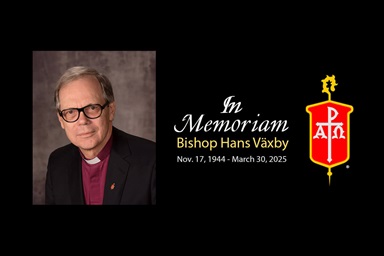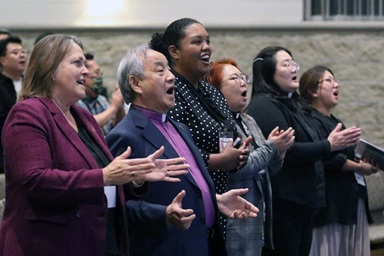Key points:
- The board of The United Methodist Church’s finance agency — the General Council on Finance and Administration — received a report on 2022 giving.
- Even amid rising church disaffiliations, overall giving to The United Methodist Church’s denomination-wide ministries saw a small uptick last year.
- However, worries remain, especially about the sustainability of funding for bishops.
United Methodists’ generosity in 2022 brought a ray of sunshine to the denomination’s otherwise cloudy budget outlook.
However, the denomination’s financial leaders still worry about storms ahead.
At an online meeting Feb. 17, the board of The United Methodist Church’s finance agency — the General Council on Finance and Administration — reviewed a report on 2022 giving.
Overall, the finance agency collected about $113.9 million in 2022 apportionments — requested shares of church giving that support denomination-wide ministries. That’s up from about $113.7 million in 2021.
While only a slight increase, the 2022 receipts halt a three-year downward trend in apportionment collections and indicate a stabilization in giving.
Paid in Full
The small boost also comes as the denomination is grappling with a mounting number of church disaffiliations after decades of intensifying internal division over LGBTQ inclusion, and the launch of a theologically conservative breakaway denomination last year.
“God is making a way through the people of The United Methodist Church who continue to give graciously and abundantly,” the Rev. Moses Kumar, the finance agency’s top executive, told the board.
Ministry is made possible, he added, “through giving by our members who believe in our ability to transform the world because of Jesus Christ.”
However, total apportionment collections are still notably lower than 10 years ago when people were still recovering from a global recession.
Apportionments are what sustain United Methodist ministry beyond the work of individual congregations. Denomination-wide ministries receive apportionments from annual conferences, regional church bodies that in turn receive apportionments from local churches. About 90% of the offering remains in the local church.
U.S. conferences distribute their apportionments among seven general-church funds. Each fund supports a different category of ministry: bishops, ministerial education, general administration, the Black College Fund, Africa University, ecumenical work and the World Service Fund that supports the work of most general agencies,
Central conferences — church regions in Africa, Europe and the Philippines — also pay apportionments but only to the Episcopal and General Administration funds.
The pandemic has played a significant role in diminished apportionment receipts in recent years, not least in postponing General Conference, the denomination’s top lawmaking assembly, from 2020 to now 2024.
While the denomination is still officially operating under the budget General Conference passed in 2016, a number of annual conferences are already paying apportionments based on the significantly reduced budget the finance agency’s board has long planned to submit to the coming General Conference.
Rising church disaffiliations also are a contributing factor both in current giving patterns and the plans for a record-low general church budget.

So far, annual conferences have ratified the withdrawal of about 2,000 congregations under a disaffiliation provision that took effect in 2019. Annual conferences expect to administer more such disaffiliations in the coming months before the provision expires at the end of the year.
Nevertheless, U.S. apportionment collections — which fund the bulk of denomination-wide ministries — were up overall in 2022.
The World Service Fund — the biggest of the apportioned funds — saw a collection rate of 73.2% in 2022 compared to 72.5% the previous year (when the fund saw its lowest collections since 2005). That represents an increase of $600,000.
Similarly, the General Administration Fund collection rate in the U.S. went up to 75.7% in 2022, compared to 75.5% in 2021. That represents an increase of about $25,000.
The Episcopal Fund, which supports the work of bishops, continues to have the highest collection rate at 92.9%, but that rate was down slightly from 2021, when it was 93.8%.
Stipends for bishops
The Episcopal Fund revenue in 2022 was still $1.98 million better than the budget. That’s in large part due to reduced expenses because bishops held their meetings online and especially because a number of bishops took on expanded workloads to cover for retiring colleagues.
Nevertheless, the Episcopal Fund remains a particular source of concern for the finance agency’s board.
In 2019, the Episcopal Fund was in danger of running out of money in a few years. The pandemic actually has helped the bishops build up their reserves by reducing travel and ultimately the number of bishops in active service.
Late last year, United Methodists held bishop elections to name successors to some of the retiring bishops. The delegates elected 13 new bishops in the U.S., three in the Philippines and one in Central and Southern Europe. That still represents seven fewer than in the current budget.
Rick King, the finance agency’s chief operations officer, said even without the full cohort of allotted bishops “we’re still running at a deficit — a significant deficit.”
If the coming General Conference approves returning to a full allotment of 66 bishops, he added, “You’ll start to deplete the reserves at a very high rate.”
General Conference also has received legislation to add five more bishops in Africa — a plan that has long been in the works.
Bill Brownson, a GCFA board member and the West Ohio Conference’s treasurer, suggested the agency look at different scenarios for reducing the number of bishops. He also suggested that the agency look for ways to decouple the discussion of the Episcopal Fund from the rest of the denominational budget.
“I don’t propose it’s easy, and it’s not, of course, how we’ve done it before,” he said.
As things stand, Brownson said, the rest of the denomination’s budget is “a derivative of the Episcopal Fund budget.”
The Rev. Steve Wood, who chairs the board committee that deals with the general church budget, said Brownson raised an interesting idea.
“You’re absolutely right,” Wood told Brownson. “We’re in a domain where if we continue to do things the way we have historically done things, it’s not likely to solve the long-term sustainability issue.”
Hahn is assistant news editor for UM News. Contact her at (615) 742-5470 or [email protected]. To read more United Methodist news, subscribe to the free Daily or Friday Digests.




